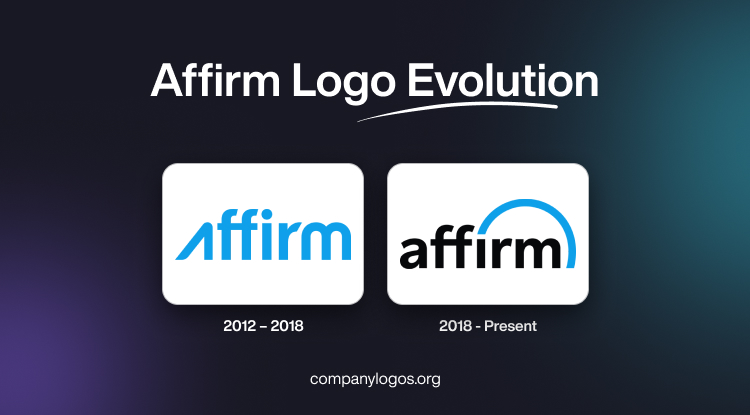
Affirm is a US-based financial technology startup founded by Max Levchin. In fact, it was Levchin, who, by virtue of being a co-founder of the iconic PayPal, had made a name for himself in the world of fintech. However, it was with Affirm that he sought to revolutionise the way consumers approach purchases, both online and in-store.
The core concept behind Affirm was about introducing a “Buy Now, Pay Later” (BNPL) service to allow shoppers to break down the cost of their purchases into more manageable instalments. This idea aimed to provide an alternative to traditional credit cards. It offered transparency, flexibility, and a more responsible approach to managing finances.
An important part of the Affirm brand is its logo, which was changed only once. It represented the attributes of the company in terms of professionalism, innovation, and trustworthiness. The article traces the journey and evolution of the Affirm logo through the years.
The Genesis of the Affirm Logo (2012 – 2018)
The logo of Affirm in its earliest variant was devoid of any graphic element and just carried a wordmark with the name of the company. It was designed in cyan colour to offer a sense of trustworthiness and innovation. The wordmark was rendered in a bold and geometric sans-serif typeface where the letters “f” appeared as mirror images of each other connected together by a horizontal bar or stroke.
The letter “A” with a rounded top had diagonal left and vertical right lines forming a sharp angle. Executed in uppercase, the letter “A” did not carry the usual crossbar in the middle. Also, it matched the glyphs in lowercase. The letter “r,” especially its upper part, sported a diamond cut, thereby appearing dynamic. Finally, the upper part of the letter “m” was arched to form symmetry. Moreover, it did not have any vertical projection at the beginning.

(2018 – Present)
The 2018 logo iteration featured a clean, sans-serif typeface to reflect the adherence of Affirm to simplicity and transparency. However, the most striking element of the redesign was the addition of an arc symbol. It represented optimism, adaptability, and the forward-thinking approach of the company. The logo redesign offered a striking contrast with the wordmark in black set against a white background. The entire thing had a bright blue arc to symbolise the overarching commitment of the brand to support and positivity. The twin letters “f” appear as mirror images of each other but are grounded to show reliability and stability.

The Elements of the Affirm Logo
Font
The wordmark forming the visual identity of Affirm uses a bold, custom sans-serif typeface. The typeface is similar to Xyngia Demi Bold by ROHH.
Colour
The colour palette of the logo consists of blue and black. Here, black gives the logo a versatile and universal quality, while blue provides brand recognition, customer attention, and familiarity.
The History of Affirm
In 2012, a financial technology company called Affirm was born in Silicon Valley with a mission to revolutionise the way consumers approach purchases. It was co-founded by Max Levchin, who happened to be a pioneering figure known for co-creating PayPal and developing the CAPTCHA test. It was he who introduced a groundbreaking concept: “Buy Now, Pay Later” (BNPL).
This BNPL service enabled customers to make purchases immediately while paying for them over time. Importantly, the transaction did not have any hidden fees or convoluted interest rates. In doing so, Affirm partnered with Cross River Bank. Thus, Affirm aimed to facilitate this transparent and consumer-friendly approach to managing finances. From its inception, the company pursued strategic partnerships to drive growth. It also formed an alliance with One Kings Lane in 2013. Here, One Kings Lane happened to be an online retailer who specialised in home goods and furniture.
In 2014, Affirm continued to grow, thanks to a $45 million investment from Spark Capital. This infusion of funds allowed the company to expand its team and enhance its platform. In other words, the stage was set for the further expansion of the company. A significant milestone was achieved in 2016 when Affirm partnered with Shopify. This allowed Affirm and its BNPL solution to be accessed by a vast network of online sellers.
The reach of the company grew even further in 2019 when its services were made available at Walmart stores nationwide. It proved Affirm’s position as a disruptive force in the financial technology sector. This accomplishment led to the launch of the initial public offering (IPO) on Nasdaq in January 2021. This provided additional capital for growth and underscored the significant impact made by the company.
Affirm is a major player in the BNPL market and collaborates with hundreds of brands, retailers, and e-commerce platforms to offer flexible payment options. The company remains steadfast in its commitment to making financial services more accessible, transparent, and consumer-friendly. It embodies a broader movement to reshape how people perceive and utilise financial services.
Interesting Facts About Affirm
- Affirm was established in 2012 by Max Levchin, who also co-founded PayPal. The other co-founders of the company include Nathan Gettings, Jeffrey Kaditz, and Alex Rampell.
- As of 2024, Affirm is the largest U.S.-based buy now, pay later (BNPL) provider, with around 21–22 million users and processing $28 billion in payments annually.
- Affirm stands out by not charging late fees, compounding interest, or hidden fees. Customers always know exactly what they owe, which is a key part of Affirm’s commitment to transparency.
- Users can choose payment schedules, which may range from 3, 6, or 12 months at the point of sale. The annual percentage rates (APR) can range from 0–30% based on creditworthiness.
- Affirm uses machine learning to assess creditworthiness, which the company claims leads to a higher loan approval rate compared to competitors. All this while ensuring borrowers can comfortably repay their loans.
- The company earns revenue by charging service fees to merchants, interest to borrowers, or both. It also offers a savings account and a debit card.
- Affirm has major partnerships with brands like Walmart, Peloton, and Delta Vacations. Its services are integrated across a wide range of e-commerce platforms, including Shopify and Magento.
- Affirm is known for pioneering a remote-first work culture that emphasises flexibility and work-life balance for its employees.
- While primarily serving the U.S., Affirm is also available in Canada and the United Kingdom.
- The Affirm app allows users to discover deals, prequalify for loans, create virtual cards for use anywhere (including Apple Pay and Google Pay), and manage repayments. All of these are designed for a seamless and transparent shopping experience.
- Some retail partners have reported up to a 207% increase in sales volume and a 34% rise in average order value when offering Affirm as a payment option.
- The mission of Affirm is to deliver honest financial products that improve lives and prioritise customer well-being over maximising profits.
Finally
Through its inception, strategic partnerships, nationwide expansion, public listing, and visual transformation, Affirm has firmly established itself as a disruptive force in the financial technology sector. Its logo continues to define the brand and convey its values to its users. With its focus on transparency, accessibility, and consumer empowerment, the company continues to shape the future of finance, one innovative solution at a time.